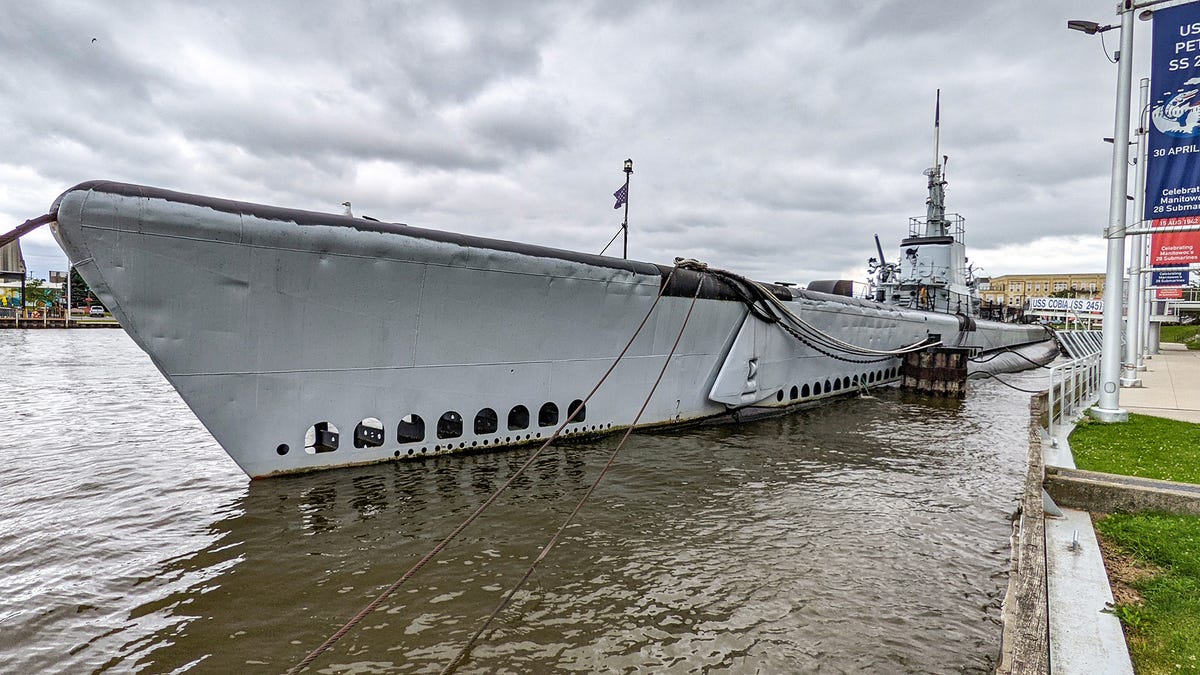 Why You Can Trust CNET
Why You Can Trust CNET Submarine in a lake? Exploring the USS Cobia and the Wisconsin Maritime Museum
An important piece of WWII Pacific fleet history, about as far from an ocean as you can get.

A lake, even one of the Great Lakes, isn't the first place you'd look for a submarine. So what's a WWII submarine doing in a tiny town on the shore of Lake Michigan? I decided to find out.
The town of Manitowoc is roughly halfway up Wisconsin's coast. It has an almost seaside feel to it, with a marina, jetty and an overall vibe that's decidedly "coastal vacation town." It wasn't always that way. As the former home of Manitowoc Shipbuilding, not only were WWII landing craft built here, many of which were used in the invasion of Normandy, but also minesweepers, merchant craft, ferries and, surprisingly enough, submarines.
Twenty-eight Gato- and Balao-class submarines were born in Manitowoc during the war. It's the only place in the US to launch submarines sideways into the water. Though the USS Cobia, a Gato-class, was built in Connecticut, it was given to the city as an example of the Gato class. Today it's a museum so, you guessed it, I had a look around.
Catshark
The USS Cobia was launched in November, 1943 and soon made its way to the Pacific Ocean for its first of six war patrols. It was finely suited for its role. The Gato-class ships, named after a species of shark, were some of the largest of the era. While this made them less maneuverable and slower to dive than their Japanese adversaries, they made up for that in other ways. Twenty-four torpedoes sat ready to launch from 10 tubes (six fore and four aft). On deck were two anti-aircraft cannons and a big 3-inch, 50-caliber deck gun to attack targets too small for torpedoes.
Its size also allowed for some surprising luxuries for the crew, perhaps the most notable being air conditioning. With 70 men and four V16 diesels in a tight, enclosed space, heat inside was going to be an issue. While AC could make the environment more pleasant for the men, it was the machines and electronics that benefited most. Condensation could lead to electrical shorts, which could lead to power outages or worse, fires. Keeping the humidity relatively low was a huge boost for reliability as well as comfort.
After the war the Cobia was briefly decommissioned, before being recommissioned in the early 1950s to act as a training ship. In that role she served for another 20 years, eventually ending up at the Naval Reserve Center in Milwaukee before being decommissioned for the last time and towed to where she is now, at the mouth of the Manitowoc river.
The Cobia is in fantastic shape for a submarine of its era, speaking to the care and effort being put into maintaining such a historic vessel. The tour, guided only, starts in the forward torpedo room, making its way past the officer's quarters, through the control room, and on through the galley, mess, crew's quarters, engine rooms, and finally at the aft torpedo room. Like most subs, stairs have been added and you enter and exit through holes cut in the hulls.
Wisconsin Maritime Museum
Though the Cobia is the main attraction of the museum, inside are several smaller boats, along with engines, all of which have special significance to the area and its shipbuilding history.
In the spring and summer the Wisconsin Maritime Museum is open every day, and Thursday through Sunday in the fall and winter. It's a lovely little museum, with a well-maintained WWII submarine.
If you're not headed to Wisconsin any time soon, check out the gallery above for a look inside the museum and the USS Cobia.
As well as covering audio and display tech, Geoff does photo tours of cool museums and locations around the world, including nuclear submarines, aircraft carriers, medieval castles, epic 10,000-mile road trips and more.
Also check out Budget Travel for Dummies, his travel book, and his bestselling sci-fi novel about city-size submarines. You can follow him on Instagram and YouTube.

